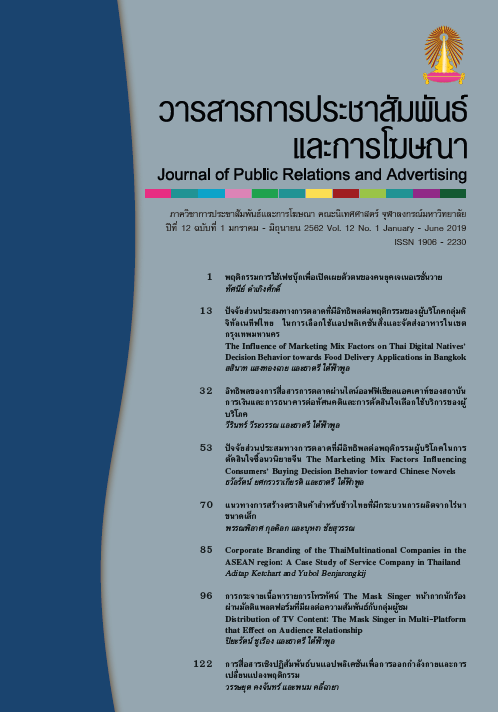Interactive Communication in Mobile Fitness Applications and Behavior Change
Main Article Content
Abstract
This research aims to explore interactive features in mobile fitness applications, self- regulation in exercising, exercise behavior change, and to describe the relations of interactive communication in mobile fitness applications, self-regulation in exercising, and exercise behavior in each stage of behavior change. The research employs mixed methods by using content analysis to analyze interactive features in 80 mobile fitness applications in order to develop a questionnaire for survey research among 400 samples who have downloaded and used mobile fitness applications at least once in the previous three months.
The results show that there are eight interactive features in mobile fitness applications, which can be classified into 30 interactive communication techniques. The survey findings illustrate that the top two interactive features used by respondents are Built-in Tutorials and Input Personal Health. The top self-regulation rated the most among respondents is Evaluation. The research has also found that most respondents behave in contemplation stage and have high level of self-regulation. The hypothesis test concludes that 1. Usage frequency of interactive features is significantly related to self-regulation in exercising with low-level positive correlation. 2. Self-regulation level is correlated with exercise behavior in Contemplation Stage, Preparation Stage and Action Stage with medium-level positive correlation and also correlated with exercise behavior in Maintenance Stage with low-level positive correlation. 3. Usage frequency of interactive features is related to Action Stage and Maintenance Stage with low-level positive correlation.
Article Details
References
กุลธิดา พานิชกุล, อติพร สำราญบัว. (2556). การประยุกต์ใช้โมเดลการปรับเปลี่ยนพฤติกรรม (Transtheoretical Model) เพื่อส่งเสริมพฤติกรรมการออกกำลังกาย. วารสารวิทยาลัยพยาบาลบรมราชชนนี นครราชสีมา, 19(1), 66-76.
สำนักงานสถิติแห่งชาติ. (2555). การสำรวจพฤติกรรมการเล่นกีฬาหรือออกกำลังกายของประชากรและสุขภาพจิต พ.ศ. 2554. Retrieved from http://service.nso.go.th/nso/nsopublish/themes/files/exerFull54.pdf:
Anderson-Bill, E. S., Winett, R. A., & Wojcik, J. R. (2011). Social Cognitive Determinants of Nutrition and Physical Activity Among Web-Health Users Enrolling in an Online Intervention: The Influence of Social Support, Self-Efficacy, Outcome Expectations, and Self-Regulation. Journal of Medical Internet Research, 13(1), e28. doi:10.2196/jmir.1551
Anderson, E. S., Wojcik, J. R., Winett, R. A., & Williams, D. M. (2006). Social-cognitive determinants of physical activity: the influence of social support, self-efficacy, outcome expectations, and self-regulation among participants in a church-based health promotion study. Health Psychol, 25(4), 510-520. doi:10.1037/0278-6133.25.4.510
Bandura, A. (1986). Social foundations of thought and action: a social cognitive theory: Prentice-Hall.
Baumeister, R. F. (2005). The Cultural Animal: Human Nature, Meaning, and Social Life: Oxford University Press.
Brown, J. M. (1998). Self-regulation and the addictive behaviors. In W. R. M. N. Heather (Ed.), Treating addictive behaviors, 2nd ed (pp. 61-73). New York, NY, US: Plenum Press.
Brown, J. M., Miller, W. R., &Lawendowski, L. A. (1999). The self-regulation questionnaire. In L. V. T. L. Jackson (Ed.), Innovations in clinical practice: A source book, Vol. 17 (pp. 281-292). Sarasota, FL, US: Professional Resource Press/Professional Resource Exchange.
Carey, K. B., Neal, D. J., & Collins, S. E. (2004). A psychometric analysis of the self-regulation questionnaire. Addictive Behaviors, 29(2), 253-260. doi: http://dx.doi.org/10.1016/j.addbeh.2003.08.001
Conroy, D. E., Yang, C. H., & Maher, J. P. (2014). Behavior change techniques in top-ranked mobile apps for physical activity. Am J Prev Med, 46(6), 649-652. doi:10.1016/j.amepre.2014.01.010
De Ridder, D., & de Wit, J. (2006). Self-Regulation in Health Behavior: Wiley.
Heeter, C. (1989). Implications of new interactive technologies for conceptualizing communication. Media use in the information age: Emerging patterns of adoption and consumer use, 217-235.
IMS Institute for Healthcare Informatics. (2015). Patient Adoption of mHealth : Use, Evidence and Remaining Barriers to Mainstream Acceptance. Retrieved from http://www.imshealth.com/files/web/IMSH%20Institute/Reports/Patient%20Adoption%20of%20mHealth/IIHI_Patient_Adoption_of_mHealth.pdf:
Lee, I. M., Shiroma, E. J., Lobelo, F., Puska, P., Blair, S. N., &Katzmarzyk, P. T. (2012). Effect of physical inactivity on major non-communicable diseases worldwide: an analysis of burden of disease and life expectancy. The Lancet, 380(9838), 219-229. doi:10.1016/S0140-6736(12)61031-9
Miller, C. H. (2008). Digital Storytelling: A Creator's Guide to Interactive Entertainment: Taylor & Francis.
Prochaska, J. O., &Velicer, W. F. (1997). The transtheoretical model of health behavior change. Am J Health Promot, 12(1), 38-48.
Rengert, J. (2011). Development and Evaluation of a Social Cognitive Theory-Based Exercise Intervention in Firefighters: 5-ALARM Fitness Program. (Doctor of Philosophy), Ohio State University, http://docplayer.net/31693289-Development-and-evaluation-of-a-social-cognitive-theory-based-exercise-intervention-in-firefighters-5-alarm-fitness-program.html.
Rovniak, L. S., Anderson, E. S., Winett, R. A., & Stephens, R. S. (2002). Social cognitive determinants of physical activity in young adults: A prospective structural equation analysis. Annals of Behavioral Medicine, 24(2), 149-156. doi:10.1207/S15324796ABM2402_12
Schunk, D. H. (1991). Self-Efficacy and Academic Motivation. Educational Psychologist, 26(3-4), 207-231. doi:10.1080/00461520.1991.9653133
Statista. (2016). Mobile health app categories that will offer the highest global market potential in the next five years (Vol. 2016). https://www.statista.com/statistics/625181/mobile-health-app-category-market-potential-worldwide/: Statista.
Stout, P. A., Villegas, J., & Kim, H. (2001). Enhancing learning through use of interactive tools on health-related websites. Health Education Research, 16(6), 721-733. doi:10.1093/her/16.6.721
Subramanian, R. (2015). Diet, exercise, and smartphones - A content analysis of mobile health application for weight loss. Southern Illinois University Carbondale. (1075)
Zimmerman, B. J., & Schunk, D. H. (1989). Self-regulated learning and academic achievement: theory, research, and practice: Springer-Verlag.


